Blog
Get To Know Team KIYOSA: Japanese Hairstylist Sumiko
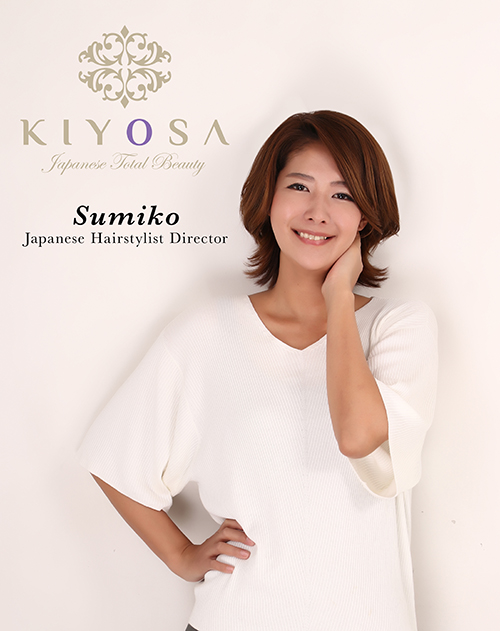
KIYOSA Japanese Total Beauty consists of a team that is well-trained and professional. This is all thanks to the training and guidance of our licensed Japanese staff. In this article, we are going to get to know one of our Japanese hairstylists, Sumiko-san! She also explained how the training process for junior hairstylists are and some tips about hair and salon appointments.
Why did you become a hairstylist?
“When I was an elementary school student I decided to become a hairstylist because it is the best occupation for females in Japan,” Sumiko-san explains that being a hairstylist is great not only because of the fulfillment she gets by helping the clients feel and look beautiful, it is also a constant learning process. “That’s what I like about working at KIYOSA. They follow the philosophy of ‘Beauty, learning, and enjoy!’. In my opinion, this is important for giving excellent service to clients.”
Before she started work at KIYOSA in 2015, she had over thirteen years of experience and training in Japan as a hairstylist. But her journey did not just start there. Hairstylists are required to get a license. This entails an exam where usually only 50% are able to pass and since it is only held once a year, they would have to wait and train more to retake the exam. To be qualified for this license, they need to study in a hair school for at least two years and get hands-on training for at least a year. Once passed, they can start working at salons by starting as a hairstylist assistant and work their way up to being a senior hairstylist.
She was also a part of a group called “Japan Overseas Cooperation Volunteers” which has received the Ramon Magsaysay Award in 2016. This award is also known as the Asian Nobel Prize which is awarded to individuals and organizations who have made outstanding achievements and contributions to economic and social development in the Asian region every year. Their organization received such award because of their volunteer work in fields such as agriculture, forestry, health, and education. They address the challenges faced by developing countries at the grassroots level.
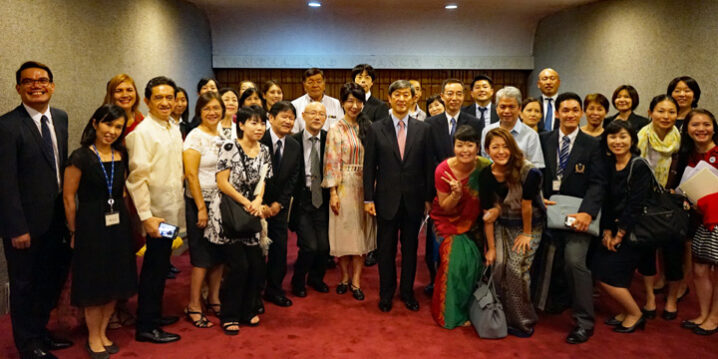
Japan Overseas Cooperation Volunteers at the Ramon Magsaysay Award in 2016
What is the difference in working in the Philippines compared to Japan?
“Of course, to work in Japan as a hairstylist is easier for me because I can easily understand them and I know the culture.” She explained that working in the Philippines can be sometimes difficult because of the language barrier. “Working here is like a roller coaster. Sometimes it’s very fun and happy. Sometimes it’s sad and disappointing.” She’s happy especially when she sees the clients love their look and the service they get at KIYOSA and they come back often but sometimes there are difficult customers which are inevitable.
What is the best part of working at KIYOSA?
For her, the best part is seeing the improvement in KIYOSA’s hair team. “When I see that their skill is improving because of the training, it is one of my happy points while working at KIYOSA. Our training for junior hairstylists is not easy, but I’m happy because I can feel that the staff is becoming better than before.”
The Filipino staff undergoes a similar training and standard that they have in Japan with the help of our Japanese hairstylists. Unless they pass the training and exam, they are not allowed to serve clients.
What are the qualities you look for in a trainee?
“Actually, we do not expect high-level skills when looking for a trainee… just a good personality. Even applicants that have no skills or experience are welcome.” She says that as long as the trainee will be able to learn and understand the Japanese service, they are willing to teach them. “They must be patient even though the training is very hard.” She emphasizes that one good quality for a trainee to have is resilience. They must be able to push through and keep themselves motivated despite the difficulties. It will not only be helpful with training but in dealing with clients as well. It cannot be helped that they will encounter clients that difficult to deal with but they still have to show them hospitality and great service with a smile.
What is the training process for hairstylists at KIYOSA?
The training for junior stylists comes in three stages, where after each stage they take a practical exam. First is the shampoo. “For shampoo, we would take a minimum of one month for training.” It might come as a surprise especially since shampoo seems like an easy task to do but Sumiko-san gives a good point on why this is the first stage of the training and why it takes a long time. “Sometimes the trainees would ask me why is the shampoo training difficult and they are curious why they need to practice this much. It’s just shampoo. Japanese salons not only focus on skills hospitality, relaxation, atmosphere… everything.” She emphasizes that KIYOSA Japanese Total Beauty’s main priority is the overall experience of the clients. “Shampoo service is just the entrance for our services, policy and showing the Japanese standard.”
Once they pass the test for shampoo, the next stage for training is hair coloring. This would usually take two to three months. “In testing the trainees’ skills for hair color we check several factors like the amount of time they take and their ability to adjust the application depending on the condition of the hair.” She says hair coloring is easier if the client has healthy and nice hair but not all clients have that. “Some clients have highly damaged hair or maybe their hair is rebonded or previously darkened which makes it harder to adjust hair coloring but we still want to achieve the client’s goal. That’s why it’s important to teach the trainees how to properly mix the necessary chemicals or colors and adjust according to the needs.”
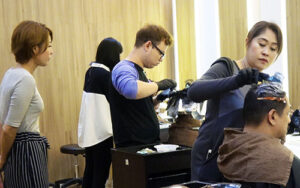
Sumiko-san and Filipino staff training for hair color.
Last and definitely not the least is the hair cut. Out of all the hair services, it is hands down the most difficult part of the training even for the Japanese when they studied and got their hairstyling license in Japan.
In total, training for KIYOSA junior hairstylist can take up to three years! This way, clients could expect that they can also meet Japanese standards for hairstylists.
To introduce our junior hairstylists, we have an ongoing promo for their services!
Hair cut: P700
Hair cut and color: starts at P2,000
Hair cut and spa: P1,000
What is your number one advice for hair care?
“Please use blower every day! Don’t let your hair naturally dry. When the hair is wet, the hair cuticle is opened. When it is opened, it is more prone to damage. Damaging hair will not make it shiny and thick. By using blower the hair cuticle will be closed and then the hair will become stronger because it does not get damaged easily.”
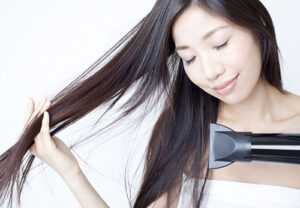
Sumiko-san tip for hair care is to blow dry your hair
As long as you do it correctly, blow-drying will not harm your hair. However, there is also a possibility of frizz, damage, and breakage if you are not blow-drying your hair properly.
The following are a few guidelines for blow-drying your hair:
1. To remove excess moisture, pre-dry your hair by pressing with a towel.
2. Choose a hairdryer that has separate controls for temperature and speed so you can easily adjust according to your hair type and minimize the risk of overdrying. Use the blow dryer with medium to low heat and speed setting if you have thin hair. For thick hair, use higher temperatures but at low speed. By the end, always finish with a cool setting to ease any flyaways, seal the hair follicle and add shine. Using a high heat setting might be quicker to dry the hair, but it will also dry out and damage the hair.
3. Sectioning the hair is key. In salons when they blow-dry hair they section off the hair into three or four depending on the amount of hair for quicker drying. This is a good practice to copy when blowdrying your hair at home.
4. Start at the front and root of your hair then work each section with a medium to large round brush, round brushing closest to the root to ensure that you are reaching maximum volume to the blowout.
Do not go over dried hair to attempt making hair smoother. Keep the blow dryer moving constantly to prevent applying too much heat in one spot.
5. Do not forget to clean your blow dryer! It can accumulate lint and debris that may cause malfunction and overheat.For more guide about blow drying at home, you can read our previous blog post here: Self Blow Drying 101
What is your favorite hairstyle/trend?
“My favorite hairstyle to do with clients is gradation bob.” A gradation bob gives volume and beautiful silhouette from the classy bob cut.
https://www.instagram.com/p/B03EAajjmHp/
https://www.instagram.com/p/BzKbqywAxTg/
Hair cut at KIYOSA Japanese Total Beauty with our Japanese staff is P1,800!
What is the difference between a local salon and a Japanese salon?
“In my opinion, the best part about Japanese salon is thinking about not only skills and technique. We also focus on the overall experience. Improving the atmosphere by having nice music, cleaning… Being hospitable by greeting the client when they come in… The client will feel that it’s worth it to go if they want to relax and look good.”
“Omotenashi” or Japanese hospitality is an important part of the standards when it comes to service. As soon as a client walks into the salon they are immediately greeted and attended to. They are offered either a cold or hot drink while they wait and even during the hair service especially if they will be doing a service for hours. The staff’s topmost priority is the client’s comfortability. For instance, during shampooing, they will be asked whether they prefer warm or cool water or if the water pressure is good. During any hair service, the staff will ask from time to time if they feel if their scalp hurts because of the chemicals. They will also ask about every aspect of your hair and will even suggest a better style that would suit the client.
What do customer need to do before going for their salon appointment?
“Sometimes the desired style of customers cannot be easily achieved because of the condition of their hair. That’s why we must do a consultation.” She says that scheduling for a consultation first is important so that the stylist can first analyze the client’s hair and they can explain to the client how the process would take and give advice on what style would look good also. It will help set the client’s expectations on what the outcome would be and minimize damage to the hair. Patch tests are also done during consultations to ensure that the client will not have any allergic reaction to the products that will be used.
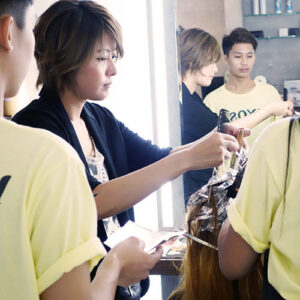
Sumiko-san demonstrating hair color during training
Generally, clients should make appointments in advance especially for complicated procedures and styles. At KIYOSA Japanese Total Beauty, you may contact 805-8888 or 0939-9158888.
It is also helpful to bring photo reference. Not only will it ease the communication with the staff especially with the Japanese staff, but it can also serve as their guide to setting the expectations of what a client’s goal is.
What are the important reminders during hair service?
“I would advise the customers not to move too much during hair service, especially during hair cut. Just relax and enjoy!”
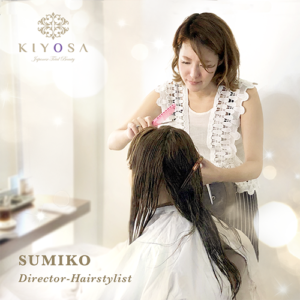
Team KIYOSA Japanese Hair Director Sumiko working on a client
How can customers take care of their hair after the appointment?
“We sell products at KIYOSA that are imported from Japan. They can use that to help care and style their hair.”
Some of the products at KIYOSA Japanese Total Beauty are:
1. Nanoamino Shampoo, which penetrates deep into the hair and gives gentle care for damage. It Makes hair soft and easy to style. Priced at P1,400.
2. Nanoamino Treatment, which cares for damaged hair while making hair bouncy, smooth and easy to style. It is Recommended to those with thin hair. Priced at P1,850.
3. Hyetal, that also enhances and maintains healthy moisturized hair. Priced at P1,600.
4. N. Hold Spray, for those want a good sense of hold and easy to style. Priced at P1,200.
5. N. natural balm, a lightweight balm made of all-natural ingredients. It moisturizes hair without a sticky feeling. Priced at P1,500.
6. Napla Art Gel Design Lock, which lets you keep a hairstyle for a long time. It is fast drying and can be reset by soaking hair with water. Priced at P1,150.
7. Loretta Gloss Spray, which makes hair smooth and shiny while suppresing the damaged hair. It is lightweight with no greasy feeling. Priced at P1,500.
“But of course, my most important advice is to use blower!”

